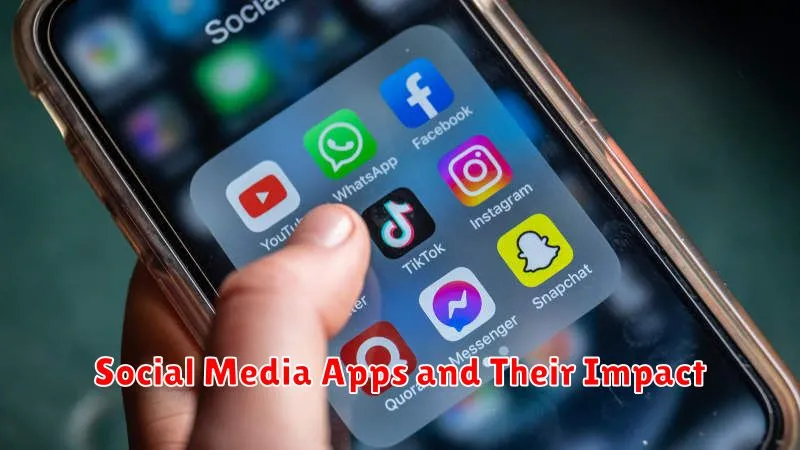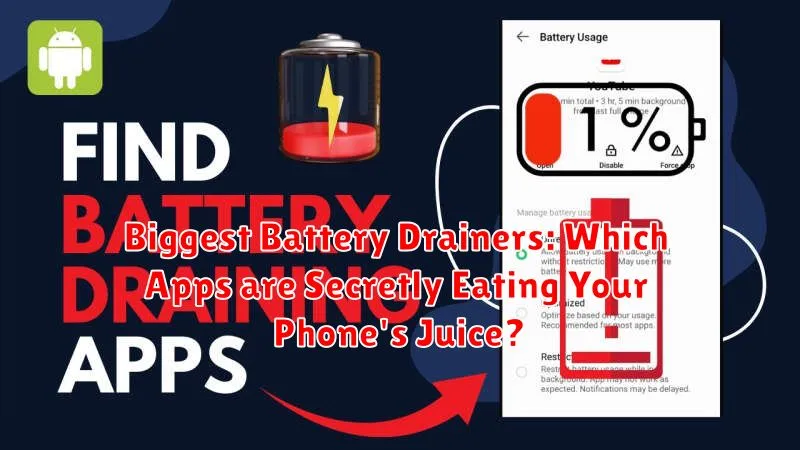Is your phone constantly tethered to a charger? Do you find yourself desperately searching for an outlet before your battery hits zero? You’re not alone. Many smartphone users experience frustratingly short battery life, often unaware of the biggest battery drainers lurking on their devices. This article will expose the apps secretly eating your phone’s juice and provide practical tips to reclaim your battery power. Learn how to identify the biggest battery drainers and which apps are the most common culprits behind your rapidly depleting battery. We’ll delve into the reasons why certain apps consume excessive power and offer strategies for optimizing your phone’s settings to maximize battery performance.
From social media apps to seemingly innocuous background processes, several factors contribute to excessive battery drain. Understanding which apps are the biggest battery drainers empowers you to take control of your phone’s battery life. This article will explore the apps secretly eating your phone’s juice, examining everything from resource-intensive games and location services to background app activity and push notifications. By identifying these biggest battery drainers, you can significantly extend the time between charges and enjoy uninterrupted usage of your device. Discover how to pinpoint the apps causing the most drain and learn effective techniques to manage their power consumption.
Understanding Battery Drain
Battery drain refers to the reduction of a mobile device’s battery charge over time. Several factors contribute to this process, ranging from active app usage to background processes and hardware components. Understanding these factors helps pinpoint the biggest battery drainers and optimize your device’s battery life.
A key concept is the difference between foreground and background activity. Foreground activity refers to apps directly in use, such as when you’re playing a game or browsing the web. These naturally consume more power. Background activity occurs when apps run behind the scenes, updating data, sending notifications, or performing other tasks. While individually these tasks might consume little power, cumulatively they can contribute significantly to battery drain.
Hardware components also play a role. The screen brightness is a major consumer. Higher brightness levels require more power. Similarly, cellular radio use, especially in areas with weak signal strength, can significantly drain battery. Other factors such as GPS usage and Wi-Fi also contribute to overall drain.
Common Culprits: Identifying Battery-Hogging Apps
Several app categories are frequently responsible for excessive battery drain. Understanding these common culprits can help you pinpoint the source of your phone’s power problems.
Location Tracking Apps: Apps that constantly track your location, such as navigation or fitness trackers, consume significant power. Limiting background location access or reducing the frequency of location updates can help conserve battery.
Apps with Constant Background Activity: Some apps continue running processes in the background, even when not actively in use. Checking your phone’s battery usage settings can reveal which apps are consuming power in the background and allow you to restrict their activity.
Resource-Intensive Apps: Apps that demand substantial processing power or utilize hardware components like the camera or GPS can quickly deplete your battery. Being mindful of how often you use these apps and closing them when finished can minimize their impact.
Social Media Apps and Their Impact

Social media apps are often cited as significant battery drainers. Their constant need to refresh and update content in the background contributes heavily to power consumption. Features like location services, push notifications, and background data usage further exacerbate this issue.
Frequent polling for new posts, messages, and notifications keeps the app active, even when not in direct use. This constant activity demands processing power and network access, both of which consume battery life. Furthermore, the visually rich nature of these apps, including videos and images, adds to the energy demand.
Excessive background activity, even when the app appears closed, can silently deplete battery power. This is especially true for apps that frequently update their feeds or utilize location tracking.
Streaming Services and Battery Consumption
Streaming services, while offering convenient entertainment, can significantly impact battery life. Video streaming, in particular, is a resource-intensive process. The constant downloading of data, combined with the display being active at higher brightness levels, contributes to substantial power drain.
Audio streaming, although generally less demanding than video, still uses power for data transfer and audio processing. Factors like audio quality (higher bitrates consume more power) and background playback further influence battery usage.
The resolution at which you stream video directly affects battery consumption. Higher resolutions like 1080p or 4K require more processing power and data transfer compared to lower resolutions, resulting in faster battery depletion.
Gaming Apps and Energy Usage
Mobile gaming has become incredibly popular, but these graphically demanding apps can significantly impact battery life. Processing power, screen brightness, and network connectivity all contribute to high energy consumption.
Games with complex 3D graphics, especially those involving online multiplayer, put a heavy strain on the phone’s processor. This constant processing requires more energy, leading to faster battery drain. Furthermore, many games encourage extended play sessions, further exacerbating the issue.
Features like vibrations and sound effects, while enhancing the gaming experience, also consume additional power. Users often max out screen brightness for optimal visibility, another contributing factor to increased battery drain.
Location Services and Background Activity
Location services and background activity are two major culprits behind excessive battery drain. Location services, used by apps like maps and ride-sharing services, constantly pinpoint your position, which requires significant power. While necessary for some apps, leaving location services always on can quickly deplete your battery.
Background activity refers to apps running processes even when you’re not actively using them. Social media apps, email clients, and news aggregators often refresh in the background to provide up-to-date information. This constant syncing and updating consumes power, even when you’re not directly interacting with the app.
Many apps request permission to run in the background. While convenient for receiving notifications and updates, this continuous activity significantly impacts battery life. It’s crucial to understand which apps are actively running in the background and manage their permissions to conserve power.
Tips for Minimizing Battery Drain by Apps

Regularly update your apps. Developers often release updates that include optimizations and bug fixes, which can improve battery performance. Ensure you have automatic updates enabled or manually check for updates periodically.
Limit background activity. Many apps consume power even when you’re not actively using them. Restrict background activity for apps you don’t use frequently. You can usually find these settings within your device’s app management options.
Turn off push notifications. Constant notifications can drain your battery. Disable push notifications for non-essential apps, opting instead for fetching updates manually when you open the app.
Manage location services wisely. While convenient, location services are a significant battery consumer. Choose “While Using the App” for location access whenever possible, instead of “Always.” Disable location services entirely for apps that don’t require it.
Dim your screen brightness. Screen brightness is a major drain on battery life. Reduce the brightness to a comfortable level, especially in well-lit environments.
How to Monitor App Battery Usage on Your Device
Knowing which apps are consuming the most power is the first step to extending your battery life. Most modern smartphones provide built-in tools to monitor battery usage by app. Here’s how you typically access this information:
Android Devices
Navigate to your device’s Settings. Then, look for Battery or Power. Within this section, you should find an option to view Battery Usage. This screen will present a list of apps ranked by their battery consumption since the last full charge.
iOS Devices
Open the Settings app and tap on Battery. The Battery Usage section will display a breakdown of battery usage by app over the last 24 hours and the last 10 days. This allows you to see both recent and long-term trends in battery consumption.
By regularly checking these tools, you can identify any power-hungry apps and take steps to manage their usage.

